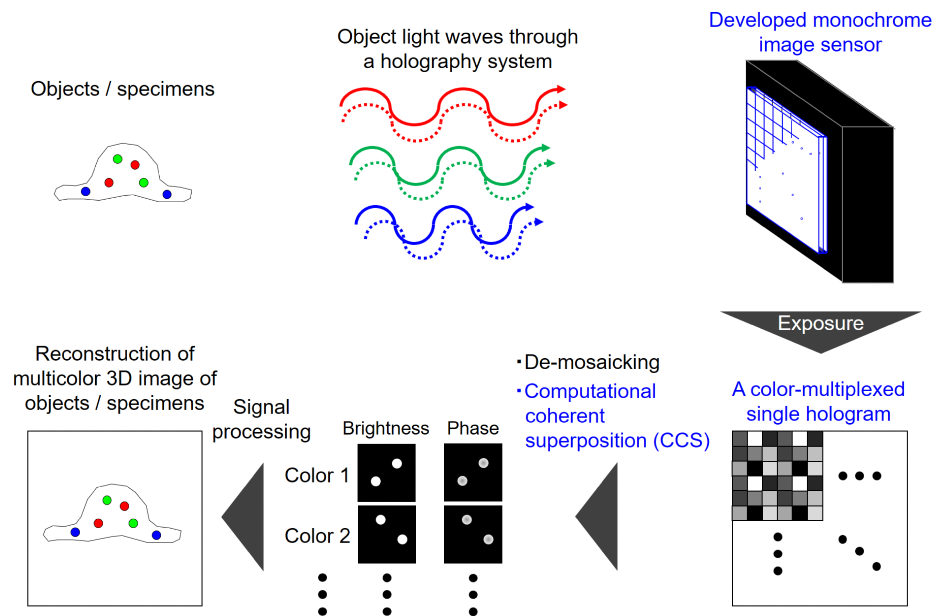Jul 23 2020
Researchers from the National Institute of Information and Communications Technology (NICT), the Japan Science and Technology Agency (JST), Toin University of Yokohama, and Chiba University have successfully developed a novel color-multiplexed holography system.
 Overview of the proposed instantaneous color-multiplexed holographic sensing technique with a computational coherent superposition (CCS) scheme. Image Credit: National Institute of Information and Communications Technology.
Overview of the proposed instantaneous color-multiplexed holographic sensing technique with a computational coherent superposition (CCS) scheme. Image Credit: National Institute of Information and Communications Technology.
An exclusively engineered and developed monochrome image sensor in the new system enables 3D information of objects irradiated by a white-light lamp and self-luminous specimens to be recorded as a single multicolor hologram.
Single-shot color-multiplexed fluorescence holographic microscopy is achieved by leveraging digital holography and computational coherent superposition (CCS), where CCS was proposed by NICT.
The newly developed microscope obtains the color 3D information of self-luminous objects with just a single-shot exposure and without the need for a color filter array. The new system avoids the need for a laser light source and can perform multicolor 3D motion-picture sensing of moving objects and biological samples at video rate.
Further advancement will be made with respect to multicolor 3D microscopy of very weak light such as non-linear light and autofluorescence light.
The study results were reported in Applied Physics Letters on July 22nd, 2020, as an open-access paper.
A single color-multiplexed fluorescence light hologram was recorded to demonstrate simultaneous color 3D sensing of various self-luminous objects. In addition, the researchers also demonstrated multicolor 3D imaging with a white-light lamp by using a single-hologram recording.
A color-multiplexed hologram was recorded on a monochrome image sensor with no color filter by employing CCS, a holographic multiplexing technique. The new system can be used to perform color fluorescence holographic 3D sensing with only a single-shot exposure.
The number of exposures needed to obtain the information is 250 times less than that needed for a traditional color-multiplexed fluorescence holographic microscope.
The new system will prove useful for high-speed multicolor holographic 3D motion-picture microscopy for temporally and spatially incoherent light, as well as multicolor holographic 3D image sensing of extremely weak light such as autofluorescence light and non-linear light, including natural light, chemically activated light, and spontaneous Raman scattering light.
Future prospects of the study would be to optimize the recording speed in holographic multidimensional sensing of extremely weak self-luminous light sources and for use in multicolor holographic 3D motion-picture image sensing for spatially incoherent light.
This study was financially supported by the Japan Science and Technology Agency (JST) Precursory Research for Embryonic Science and Technology (PRESTO) (JPMJPR16P8 and JPMJPR17P2), Japan Society for the Promotion of Science (JSPS) (18H01456), Research Foundation for Opt-Science and Technology, and Konica Minolta Science and Technology Foundation.
Journal Reference:
Tahara, T., et al. (2020) Single-shot wavelength-multiplexed digital holography for 3D fluorescent microscopy and other imaging modalities. Applied Physics Letters. doi.org/10.1063/5.0011075.
Source: https://www.nict.go.jp/en/